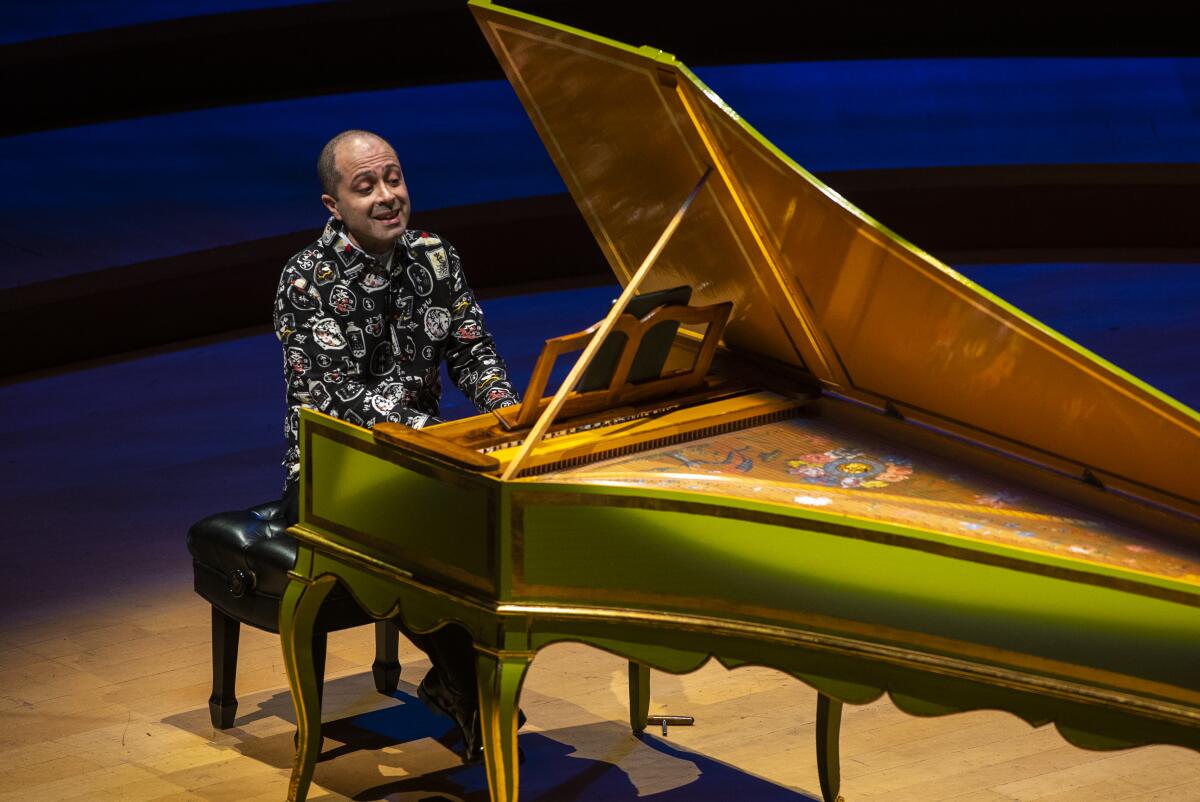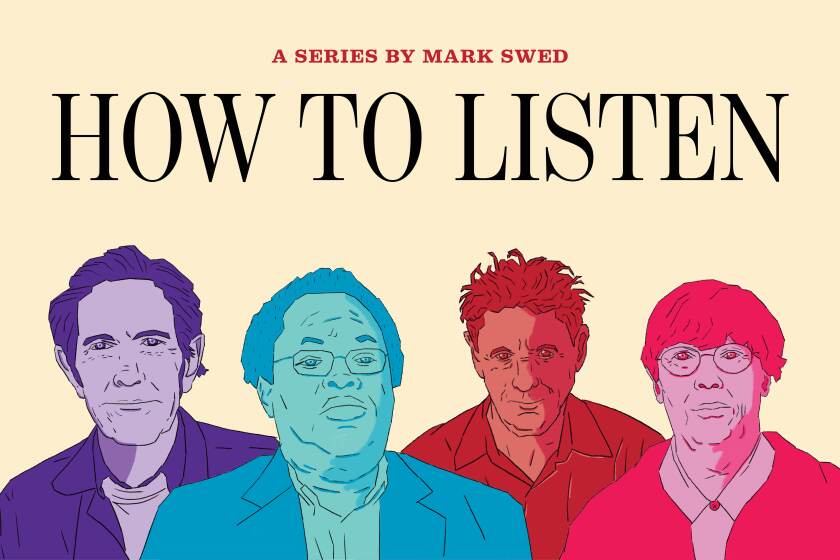Review: Mahan Esfahani proves there’s more to the harpsichord than Bach and the Baroque

The audience was small. The slight keyboard instrument painted green on the stage wasn’t imposing. Beyond the first few rows of Walt Disney Concert Hall Wednesday, the delicate sound it made was faint. But it was exquisite beyond measure.
The harpsichord can be a thankless instrument. The player has little control in shaping its sound. The strings are plucked, which means forget dynamics, one of music’s most expressive attributes. Unamplified, it is too soft for anything but the most intimate of halls, and when used with an ensemble (the way it’s most often encountered in concert), it is rarely heard at all. Composers had pretty much given up on the harpsichord by the end of the 18th century, although it got a revival of sorts in the 20th. Only a handful of harpsichordists have become well known, let alone stars.
And yet there is something about the harpsichord that makes it hard to ignore. Unlike the tone of a monster-sized grand piano, harpsichord strings, which are plucked, do not sound grounded. Music played on the harpsichord takes flight. A fugue on the piano requires effortful listening, the expectation of apprehending each layered melodic. One frets that one can’t quite comprehend the counterpoint.
Hearing a harpsichord, you rarely can comprehend the counterpoint unless you are the musician or you clamp on a pair of high-end electrostatic headphones and turn the volume up on a recording, which will also give all kinds of immersive percussion effects the mechanism makes.
But when listening in the audience, you tend to hear the sum of the parts, not the individual parts, and that can be liberating. Indeed, much about the harpsichord — as Mahan Esfahani, today’s best known harpsichordist, marvelously demonstrated in his Disney recital — is curiously liberating. The lightness of touch stimulates flights of fancy. In his program note, Esfahani likens the effect of the harpsichord to that of sketches and etchings by great painters.
The temptation to decorate, then, can be as irresistible to a harpsichordist at the keyboard as it is to an artist with a pencil in hand. Esfahani happens to be a decorator of extraordinary fancy, as was his shirt decorated with what looked like a cluttered workshop full of meters and whatnot. The first half of his program contained music by the 16th century British composer William Byrd and by Bach, or so the program told us. To a listener seated relatively close to the stage, the impression was that of eavesdropping on a harpsichordist in another room, improvising in a modern musical language.
Disney Hall is famed for its vivid acoustics, yet at relatively close proximity details could be still be hard to pick out in the clattery texture. That left two choices: attend to small sounds with as much concentration as one can muster or just daydream, letting the performance pass over you. You can, it turns out, do both.
The trick is to listen closely to, say, a splendidly meandering Byrd pavane without the distracting frustration of fussing over what your ears miss, because you will miss much. Esfahani is an impressive virtuoso with a taste for great speed.
On the other hand, if you go with the far-away flow, the still-audible harpsichord won’t leave you alone beckoning your attention. Once you realize there is no middle ground, you’re riveted. I was, anyway, and that made Byrd’s “John Come Kiss Me Now,” a series of variations I could have sworn Esfahani was making up on the spot despite knowing them well, all the more fetching.
Coronavirus may have silenced our symphony halls, taking away the essential communal experience of the concert as we know it, but The Times invites you to join us on a different kind of shared journey: a new series on listening.
In Bach’s formidable “Partita No. 6,” Esfahani really did make it up, elaborately repeating each of its two sections of its intense sarabande with harmonically modern-sounding decorations. In the last movement, a gigue, Bach’s unsettled meters can across as downright Stravinsky-an.
There were empty seats, and after intermission I moved slightly closer to the fourth row. The difference was considerable, but so was the music, Louis Andriessen’s “Overture to Orpheus.” Written for solo harpsichord in 1982, it served as a lovely tribute to the great Dutch iconoclast who died this year and who had a special love for Disney Hall (home of his favorite and most sympathetic orchestra, the Los Angeles Philharmonic, which presented the recital).
Andriessen’s imaginary overture to an imaginary opera is, itself, a lovely tribute to the harpsichord. In this closer acoustic perspective, single notes stood out with percussive brilliance, ringing like gongs of different registers. Indonesia and its gamelan orchestras didn’t seem so far away.
Esfahani returned to the Baroque with seven Scarlatti sonatas. In these, there was no suggestion of improvisation, just myriad harpsichord effects that revealed an unexpected variety of tone from his three-year-old, two-register instrument built in Los Angeles by Curtis Berak. The Berak could only play so loudly, but in exhilarating percussive passages Esfahani stomped his foot as though that might matter, and it did. The eye can make the ear surprisingly suggestible.
Once more, there were suggestions of modernity when Esfahani emphasized rhythmic grooves that in certain passages presaged the minimalist patterning of Steve Reich (whose music Esfahani has recorded).
Esfahani ended his recital with a lacy Purcell encore, “Ground in C Minor.” But he ended his program note with the promise that next time he comes back to L.A., it will be for an evening of new and modern music. It may not be all that different. Old or new, Esfahani can make one thankful to abide a thankless instrument. There might even be a life lesson in that act.
More to Read
The biggest entertainment stories
Get our big stories about Hollywood, film, television, music, arts, culture and more right in your inbox as soon as they publish.
You may occasionally receive promotional content from the Los Angeles Times.












